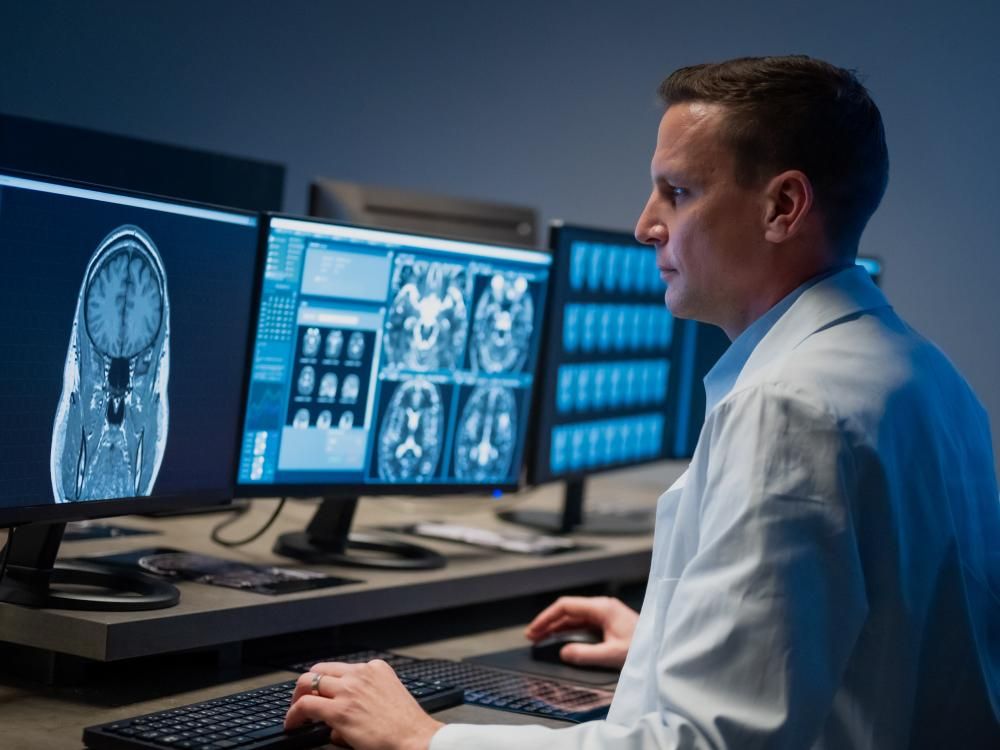
Hospital inventory management software: architecture, features, and platforms
June 29, 2023
- Home
- Healthcare software development solutions & services
- Hospital inventory management

by Sergey Ivanov,
Head of Healthcare Center of Excellence
Medical products cover many items, from disposable syringes to expensive implants and surgical kits. These higher-value consumables make up the lion’s share of a hospital’s budget, so tracking medical inventory is crucial for efficient financial management.
Backed by healthcare industry knowledge and expertise, our specialists can develop and implement tailor-fit hospital management software for your healthcare facility.
Table of contents
the global HIMS market size by 2027
ReportLinker
global HIMS market CAGR, 2022 - 2027
Mordor Intelligence
annual healthcare system cost saving due to increased automation
CAQH Index 2022
Main features of hospital inventory management software

Stock tracking
- Real-time tracking of drugs, medical supplies, and equipment in stock
- Generating unique barcodes with an item locator
- Enabling alerts on supply levels, expiration, and reorder
- Setting low stock alerts for critical items
Medical supply management
- Managing medical supply data (ID, price, intended use description, etc.)
- Counting medical supply usage cycles for forecasting demand
- Controlling medical supply allocation
- Viewing activity history of medications
Medical equipment management
- Controlling and analyzing equipment use
- Viewing activity history of medical equipment
- Controlling medical device allocation
Inventory automation
- Setting up automated expiration dates control
- Enabling automatic alerts of equipment maintenance dates and warranty ends
- Monitoring drug and medical supply cost
Order control
- Creating lists of purchase orders with required quantities
- Enabling inventory minimums for every item
- Streamlining procurement strategies
Security & compliance
- Providing role-based user access
- Enabling just-right access to all care team members
- Ensuring HIPAA compliance
- Setting up the rules for creating discrepancy reports
Audits & reporting
- Viewing all inventory data on a user-friendly dashboard
- Creating custom fields to track any available detail
- Creating customized reports for different user roles
- Generating consumption reports for the past 30-60 days
- Demand forecasting for drugs and supplies
Want to streamline your hospital inventory management?
Inventory management solution architecture
Hospital inventory management tools comprise three essential components:
- A web and mobile application that lets nurses and clinicians interact with the inventory effectively
- A connected ecosystem for asset tracking and status monitoring
- Integrations with hospital software in place that power informed decisions
Scheme title: Web/mobile app architecture
Data source: researchgate.net — A software architecture for inventory management system
RFID technology
Radiofrequency identification (RFID) technology is increasingly implemented for tracking assets in several industries, including healthcare, and employs wireless communication to identify and track people, goods, and equipment.
Tagging hospital supplies helps track their usage and ensure fast check-out and check-in for medical personnel. Adding tags on inventory items also prevents theft and losses, thus reducing inventory costs for providers. It also streamlines the maintenance of the equipment and helps assigned specialists to monitor the lifecycle of expensive hospital items.
Required integrations
Hospital inventory management software
for automatic recording of medications/equipment provided to patients
for remote access to HIMS solutions anytime from mobile devices
for medical products and supplies replenishment
Medication discrepancy tracker
for identifying medication theft
for usage patterns analysis and demand forecasting
Customer spotlight

400
blood centers use the tool
Medical equipment management software
Our medical software developers created an inventory management solution for a med tech company. The tool collects, stores, and processes large blood volumes for labs and blood centers. The team also developed a separate module for uniting devices from different manufacturers in a station which streamlined device traceability.

100,000
accessible defibrillators
A medical device tracking database
Itransition’s team developed a web app providing doctors, defibrillator owners, ambulance specialists, and admins with real-time data on defibrillators available nearby. The owners can register their device, access type (public or restricted), location, and status (in or out of service). In addition, our team enabled regular synchronization between the central database and the local ambulance systems.
Top hospital inventory management platforms
Effective inventory management has always been a pain point for medical facilities. As a result, some vendors have developed full-scale systems to alleviate the challenge for medical organizations. Here are five platforms to consider:
The Salesforce Health Cloud platform facilitates healthcare operations and workflows, including medical facility inventory management. Authorized users can view all medicine and medical supplies items necessary for each patient visit and their location and are notified of any shortfalls to address in advance. They can request a transfer of the required medication or equipment from another provider's facility when needed. Users then capture product serial numbers on-site for order authorization and scan barcodes for more efficient inventory tracking. The solution is HIPAA and 21 CFR Part 11 compliant and supports advanced triaging.
Pricing
- Enterprise: $300 user/month
- Unlimited: $450 user/month
- Free trial available
Microsoft Cloud for Healthcare is a reliable, secure, and highly flexible foundation for building customized hospital inventory management systems. By leveraging the platform's ability to integrate flawlessly with multiple data sources and its powerful analytical capabilities, healthcare organizations can monitor real-time inventory levels and equipment status, gain insights into asset usage patterns, and predict and optimize stock levels, reducing waste and ensuring the availability of critical supplies and equipment.
Pricing
- Depends on the Microsoft licenses used
- Free 30-day trial available
Healthcare providers can use Oracle’s RF Smart healthcare inventory management solution to manage their supply chain operations from one central platform. Admins can track stock levels, gain insights into warehouse operations, and trace items using barcode scanning. The solution helps them effectively supervise and optimize inventory management processes. It also enables automatic receiving, picking, counting, and shipping activities, improving productivity and lowering operational costs.
Pricing
- Available upon request
- No free trial
This platform is a procure-to-pay software for healthcare facilities. The tool provides a set of customizable modules to fit any healthcare provider and enable full control and visibility across all locations. Envi enables in-app purchasing and integrations with a healthcare provider’s clinical and financial systems to prevent duplicate entries.
Pricing
- $400 per month
- No free trial
The medical inventory management software by Stanley Healthcare is a web-based solution. Users can manage their medical facility’s inventory from any preferred place and any device with an internet connection. In addition, the system implements necessary security measures: only authorized users have permission to log in and access the areas they should view and manage.
Pricing
- Available upon request
- No free trial
This cloud-based platform provides visibility into products used across all health system locations and automates ordering processes. The system continuously checks for price changes and discrepancies so the healthcare organization receives real-time pricing updates on each product. What’s more, the solution easily integrates with MMIS, ORIS, EHR, and healthcare ERP, ensuring interoperability throughout the organization. As a result, the tool accelerates the delivery of supplies and medicine to required locations, saves time for healthcare organization’s personnel, and helps cut the supply chain expenses.
Pricing
- Available upon request
- No free trial
Custom hospital management system
Our healthcare software developers can build a tailor-made inventory management system for your hospital from scratch or customize a ready-made HIM solution according to your needs. We can carry out full-scale software development, from requirements gathering to solution development and QA at all stages. We also integrate the inventory management solution into your digital ecosystem and set up the necessary configurations.
Implementation roadmap
A step-by-step implementation of a hospital inventory management project includes the following actions:
1
Requirements gathering & system design
2
Project planning
3
System development
4
System integrations
5
Data migration
6
Solution deployment
7
User training
8
Post-launch maintenance & support
Benefits of hospital inventory management systems
Automated hospital inventory management offers providers a range of benefits that help solve critical industry challenges.
Expenditure control
A hospital inventory management solution reduces excessive purchases "for a rainy day" and stockouts to a minimum and helps to keep increasing expenses at bay.
Improved visibility
Inventory tracking software powered by healthcare IoT capabilities enables healthcare providers to oversee inventory and stock levels in real time.
Access control
Hospital administrators gain more control over inventory access and ensure that only authorized employees can view and handle certain information.
Streamlined workflows
Automated inventory management allows clinicians and nurses to clearly view the key attributes of their tasks, namely who is responsible, what they should do, and when.
Upscaled medical staff productivity
Advanced search functions and barcode scanning for data entry allow medical staff to find what they need much faster, which improves their productivity.
Reduced drug waste
Automated monitoring of drug expiry dates minimizes medication waste, resulting in cost savings.
Enhanced data analytics
Such solutions let medical facilities keep track of inventory levels, detect patterns, and forecast demand. It helps prevent stockpiling and stockouts and lower hospital inventory costs.
Improved security
Hospital inventory management solutions support multi-factor user authentication and comply with HIPAA to ensure data security.
Challenges of hospital inventory management & potential solutions
Challenges
Solutions
System cost
Implementation of hospital inventory management systems can require hefty investments.
Implementation of hospital inventory management systems can require hefty investments.
Select an inventory management tool according to your practice needs and the available budget. Subscription-based solutions can be a good option for a limited budget as they don’t require high initial payments, but the TCO can grow in the long run. Meanwhile, a custom solution requiring higher initial investments can be more cost-efficient. Itransition’s experts can help you choose and implement a HIMS solution that fits your clinic best.
Lack of data ready to import
Doctors and nurses often prepare charge captures and preference cards manually. As a result, it can cause inconsistencies and errors in the inventory management system.
Doctors and nurses often prepare charge captures and preference cards manually. As a result, it can cause inconsistencies and errors in the inventory management system.
Data quality should be verified before migrating inventory data to a new inventory management system. Assigning this task to doctors and nurses can be inefficient due to their excessive professional load and human factor limitations. Instead, healthcare inventory solution providers can review customer's data and identify incomplete or erroneous data and duplicates. Then the customer can fix those bugs effectively and swiftly.
Lack of efficient reporting
Without an inventory management solution, hospital employees have to spend much time creating progress reports manually, but this reporting method is prone to errors and erroneous conclusions.
Without an inventory management solution, hospital employees have to spend much time creating progress reports manually, but this reporting method is prone to errors and erroneous conclusions.
A hospital inventory management solution provides automated report generation. Users can select necessary parameters and set a time frame to get insightful reports in minutes. Automated reports give clinicians more time to focus on their professional tasks, increasing productivity.
User adoption
As a rule, key system users can have difficulties during onboarding due to their lack of computer skills and resistance to change. They’ve learned how to manage inventory manually and have gotten used to the hurdles, and now with the new tool, they have to relearn.
As a rule, key system users can have difficulties during onboarding due to their lack of computer skills and resistance to change. They’ve learned how to manage inventory manually and have gotten used to the hurdles, and now with the new tool, they have to relearn.
HIMS tool providers offer user training and onboarding manuals for different user roles to smoothen the process. In addition, they stay with their customers post-launch to tackle any potential challenges with the inventory management system.

Time to revitalize your hospital’s inventory management
Providers and medical personnel deal with various challenges daily, and an effective inventory management system can help mitigate many of them and reduce their detrimental effects. Besides lowering the inventory cost, hospitals can allocate additional funds to solving other critical issues. A solid healthcare inventory management system helps improve the quality of patient care and streamline supply-related operations. If you need to bring your inventory management to a new level, Itransition’s experts are here to help.

Need to upscale your inventory management?
FAQ
How can we manage hospital inventory?
Is inventory management critical for a hospital?
What is the best software for tracking & managing inventory?

Service
Healthcare software development solutions & services
Entrust your medical software development to a company with 25+ years of experience in healthcare IT. Compliance and security guaranteed.

Service
Medical device software development services
As a medical device software development company, Itransition implements apps for precise diagnostics, streamlined care delivery and management. Get a quote.

Service
Healthcare data analytics services: key types, features, and applications
Discover how our healthcare data analytics services can enhance patient loyalty while growing revenue and learn which solutions fit your business goals.

Insights
IoT for healthcare: a comprehensive technology overview & top applications
Discover healthcare IoT use cases, benefits, and challenges. Learn how IoT in healthcare works and what platforms to consider when implementing medical IoT.

Case study
A BPM solution for medical staffing services
Discover how Itransition delivered a custom Odoo-based CRM/ERP/HR suite for a US medical staffing company.

Case study
UX design for FDA-cleared neuroimaging software
Learn how Itransition’s experts improved the neuroimaging software’s user experience and helped the customer get FDA clearance for it to enter the US market.
More about healthcare software services
Services
EHR
Telehealth